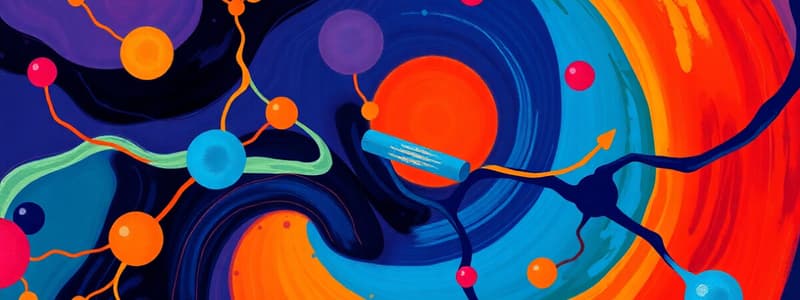Podcast
Questions and Answers
What is the primary action of cholinergic agonists on the parasympathetic nervous system?
What is the primary action of cholinergic agonists on the parasympathetic nervous system?
- They inhibit the action of acetylcholine.
- They mimic the effects of acetylcholine. (correct)
- They decrease the production of acetylcholine.
- They block the receptors for acetylcholine.
Which type of cholinergic receptor is primarily responsible for stimulating smooth muscle and slowing the heart rate?
Which type of cholinergic receptor is primarily responsible for stimulating smooth muscle and slowing the heart rate?
- Beta receptors
- Muscarinic receptors (correct)
- Nicotinic receptors
- Alpha receptors
What is the primary function of cholinesterase in the nervous system?
What is the primary function of cholinesterase in the nervous system?
- To synthesize acetylcholine.
- To break down acetylcholine. (correct)
- To bind to acetylcholine receptors.
- To stimulate the release of acetylcholine.
What is the primary mechanism of action of indirect-acting cholinergic agonists?
What is the primary mechanism of action of indirect-acting cholinergic agonists?
Which of the following is NOT a common response to the administration of cholinergic agonists?
Which of the following is NOT a common response to the administration of cholinergic agonists?
Which of the following pairs of cholinergic receptors are found in the skeletal muscles?
Which of the following pairs of cholinergic receptors are found in the skeletal muscles?
What is the difference between reversible and irreversible cholinesterase inhibitors?
What is the difference between reversible and irreversible cholinesterase inhibitors?
What is the primary clinical application of cholinesterase inhibitors?
What is the primary clinical application of cholinesterase inhibitors?
What are the two main categories of adrenergic antagonists based on receptor selectivity?
What are the two main categories of adrenergic antagonists based on receptor selectivity?
How do alpha-blocking agents work?
How do alpha-blocking agents work?
What is a key difference between selective and nonselective alpha blockers?
What is a key difference between selective and nonselective alpha blockers?
What is a potential adverse effect of nonselective beta blockers?
What is a potential adverse effect of nonselective beta blockers?
Which of the following is a clinical use of adrenergic neuron blockers?
Which of the following is a clinical use of adrenergic neuron blockers?
What is the mechanism by which beta blockers decrease heart rate?
What is the mechanism by which beta blockers decrease heart rate?
What is a potential consequence of abruptly discontinuing beta blockers?
What is a potential consequence of abruptly discontinuing beta blockers?
Why is the use of nonselective beta blockers contraindicated in patients with asthma?
Why is the use of nonselective beta blockers contraindicated in patients with asthma?
What is the primary use of irreversible cholinesterase inhibitors?
What is the primary use of irreversible cholinesterase inhibitors?
What is the primary clinical indication for reversible cholinesterase inhibitors?
What is the primary clinical indication for reversible cholinesterase inhibitors?
What is the mechanism of action of cholinergic antagonists?
What is the mechanism of action of cholinergic antagonists?
What is the main effect of anticholinergics on the heart?
What is the main effect of anticholinergics on the heart?
What is the main effect of anticholinergics on the gastrointestinal tract?
What is the main effect of anticholinergics on the gastrointestinal tract?
Which of the following is NOT a common effect of anticholinergics?
Which of the following is NOT a common effect of anticholinergics?
Which type of cholinergic receptor is primarily involved in the effects of anticholinergics?
Which type of cholinergic receptor is primarily involved in the effects of anticholinergics?
What is the primary effect of anticholinergics on the central nervous system (CNS)?
What is the primary effect of anticholinergics on the central nervous system (CNS)?
What is the mechanism by which direct-acting sympathomimetics exert their effect?
What is the mechanism by which direct-acting sympathomimetics exert their effect?
Which of the following is NOT an endogenous catecholamine?
Which of the following is NOT an endogenous catecholamine?
What is the main effect of stimulating alpha1-adrenergic receptors?
What is the main effect of stimulating alpha1-adrenergic receptors?
Which of the following enzymes is responsible for the inactivation of norepinephrine inside the neuron?
Which of the following enzymes is responsible for the inactivation of norepinephrine inside the neuron?
What is the mechanism of action of alpha2-adrenergic agonists?
What is the mechanism of action of alpha2-adrenergic agonists?
What is the term for drugs that block the effects of adrenergic neurotransmitters?
What is the term for drugs that block the effects of adrenergic neurotransmitters?
Flashcards
Cholinergic Agonists
Cholinergic Agonists
Drugs that stimulate the parasympathetic nervous system by mimicking acetylcholine.
Cholinergic Antagonists
Cholinergic Antagonists
Drugs that block the action of acetylcholine in the parasympathetic nervous system.
Muscarinic Receptors
Muscarinic Receptors
Cholinergic receptors that stimulate smooth muscle and slow heart rate.
Nicotinic Receptors
Nicotinic Receptors
Signup and view all the flashcards
Direct-Acting Agonists
Direct-Acting Agonists
Signup and view all the flashcards
Cholinesterase Inhibitors
Cholinesterase Inhibitors
Signup and view all the flashcards
Reversible Inhibitors
Reversible Inhibitors
Signup and view all the flashcards
Irreversible Inhibitors
Irreversible Inhibitors
Signup and view all the flashcards
Reversible cholinesterase inhibitors
Reversible cholinesterase inhibitors
Signup and view all the flashcards
Irreversible cholinesterase inhibitors
Irreversible cholinesterase inhibitors
Signup and view all the flashcards
Effects of anticholinergics
Effects of anticholinergics
Signup and view all the flashcards
Mydriasis
Mydriasis
Signup and view all the flashcards
Adrenergic agonists
Adrenergic agonists
Signup and view all the flashcards
Alpha1 receptors
Alpha1 receptors
Signup and view all the flashcards
Beta1 receptors
Beta1 receptors
Signup and view all the flashcards
Beta2 receptors
Beta2 receptors
Signup and view all the flashcards
Dopaminergic receptors
Dopaminergic receptors
Signup and view all the flashcards
Monoamine oxidase (MAO)
Monoamine oxidase (MAO)
Signup and view all the flashcards
Sympathomimetic drugs
Sympathomimetic drugs
Signup and view all the flashcards
Nonselective adrenergic drugs
Nonselective adrenergic drugs
Signup and view all the flashcards
Adrenergic antagonists
Adrenergic antagonists
Signup and view all the flashcards
Alpha-adrenergic antagonists
Alpha-adrenergic antagonists
Signup and view all the flashcards
Selective vs Nonselective alpha blockers
Selective vs Nonselective alpha blockers
Signup and view all the flashcards
Beta blockers
Beta blockers
Signup and view all the flashcards
Intrinsic sympathomimetic activity (ISA)
Intrinsic sympathomimetic activity (ISA)
Signup and view all the flashcards
Effects of beta blockers
Effects of beta blockers
Signup and view all the flashcards
Adrenergic neuron blockers
Adrenergic neuron blockers
Signup and view all the flashcards
Consequences of abrupt beta blocker cessation
Consequences of abrupt beta blocker cessation
Signup and view all the flashcards
Study Notes
Cholinergic Agonists and Antagonists
- Cholinergic agonists (parasympathomimetics) mimic acetylcholine, a parasympathetic neurotransmitter.
- Cholinergic receptors include muscarinic (smooth muscle, heart rate) and nicotinic (skeletal muscle).
- Cholinergic agonists are categorized as direct-acting (receptor activation) or indirect-acting (inhibiting cholinesterase).
- Cholinesterase inhibitors (acetylcholinesterase inhibitors/anticholinesterases) prevent acetylcholine breakdown.
- Reversible inhibitors bind cholinesterase temporarily (minutes to hours).
- Irreversible inhibitors permanently bind cholinesterase.
- Major cholinergic agonist responses: increased bladder/GI tone, miosis (pupil constriction), and increased neuromuscular transmission. Other effects include decreased heart rate/blood pressure and increased secretions.
- Cholinesterase inhibitors treat myasthenia gravis and Alzheimer's disease.
- Irreversible cholinesterase inhibitors primarily treat glaucoma.
- Cholinergic antagonists (muscarinic antagonists/anticholinergics) block acetylcholine's actions at receptors.
- Key organs affected by anticholinergics: heart, respiratory tract, GI tract, urinary bladder, eyes, and exocrine glands
- Anticholinergics produce opposite effects to cholinergic agonists (decreased GI motility, salivation, increased pulse rate).
- Anticholinergics block the parasympathetic system, allowing the sympathetic system to dominate.
- Anticholinergics are used to lessen tremors and rigidity in parkinsonism.
Adrenergic Agonists and Antagonists
- Adrenergic agonists (sympathomimetics) mimic the sympathetic neurotransmitters norepinephrine and epinephrine.
- Adrenergic agonists act on several receptors in various tissues (e.g., heart, lungs, GI tract).
- Key adrenergic receptors include alpha1, alpha2, beta1, beta2 (and dopaminergic).
- Alpha1 receptors cause vasoconstriction.
- Alpha2 receptors inhibit norepinephrine release, reducing vasoconstriction.
- Beta1 receptors increase heart rate and contractility.
- Beta2 receptors relax smooth muscles (lungs, GI tract).
- Dopaminergic receptors cause vasodilation.
- Neurotransmitter inactivation occurs through reuptake, enzymatic degradation (e.g., MAO, COMT), or diffusion.
- Drugs can prolong neurotransmitter action by inhibiting reuptake or degradation.
- Adrenergic agonists are classified as direct-acting, indirect-acting, or mixed-acting.
- Catecholamines include epinephrine, norepinephrine, and dopamine (endogenous). Synthetic catecholamines include isoproterenol and dobutamine.
- Epinephrine acts on multiple receptors (alpha1, beta1, beta2).
- Nonselective drugs affect more than one receptor; selective drugs affect a specific receptor.
- Alpha2 drugs reduce blood pressure centrally.
- Adrenergic antagonists (sympatholytics) block adrenergic receptor sites, preventing neurotransmitter action.
- Antagonists block alpha and beta receptors.
- Alpha blockers (alpha1-blockers, nonselective alpha blockers) treat peripheral vascular disease and benign prostatic hyperplasia.
- Beta blockers decrease heart rate which usually decreases blood pressure. Nonselective beta blockers block beta1 and beta2 (affect lungs).
- Intrinsic sympathomimetic activity (ISA) describes the ability of certain beta blockers to partially activate receptors.
- Beta blockers treat hypertension, angina, and myocardial infarction (MI)
- Beta blockers should be tapered gradually.
- Adrenergic neuron blockers decrease blood pressure by inhibiting norepinephrine release.
Studying That Suits You
Use AI to generate personalized quizzes and flashcards to suit your learning preferences.




